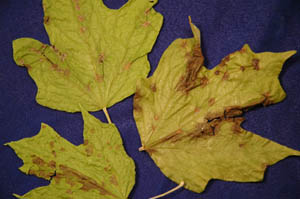Anthracnose of Shade Trees | |
|---|---|
| May 9, 2008 | |
|
Overall shade tree growth in Illinois has been favored by the weather this spring. Rains have been plentiful but not excessive in most areas. Low temperatures caused some pockets of injury but generally did not dip low enough to cause frost damage. On the other hand, several periods of cool, wet weather have been ideal for the development of anthracnose. Anthracnose causes water-soaked leaf spots ranging in color from dark green to brown. Some tree species, such as ash, oak, maple, and sycamore, may also form small twig cankers where anthracnose fungi may reside. Other trees are susceptible to varying degrees as well, but the trees just listed are the species on which we traditionally see anthracnose in Illinois in the spring. Dogwood anthracnose is much more severe but occurs later in the season. Look for dogwood anthracnose in June. The image shows recent anthracnose on maple from southern Illinois.  Lesions on maple leaves often occur along veins but may be scattered on the leaf as well. Ash anthracnose lesions move in from the leaf margins. Oak anthracnose is more evenly distributed over the infected leaf. Frost injury causes entire leaves or leaf tips to turn black and usually appears worst on the newest leaves. Frost damage happens suddenly, usually overnight, and across a wide range of species. Lesions on maple leaves often occur along veins but may be scattered on the leaf as well. Ash anthracnose lesions move in from the leaf margins. Oak anthracnose is more evenly distributed over the infected leaf. Frost injury causes entire leaves or leaf tips to turn black and usually appears worst on the newest leaves. Frost damage happens suddenly, usually overnight, and across a wide range of species.Anthracnose diseases of shade trees require cool, wet conditions for infection, most of which occurs in the 2 weeks following bud break. Succulent new plant growth is most susceptible. Older leaves and drier conditions later in the season usually retard repeating cycles of infection. Sycamores appear to be leafing out slowly this year. If you look more closely, you may see that the first buds were killed, probably by anthracnose. Don’t worry; warmer temperatures will promote a second flush of healthier leaves. As a reminder, generally fungicides are not recommended to fight anthracnose of shade trees. We recommend that you help the tree produce a new flush of foliage by providing water in periods of drought. Dogwood anthracnose, which shows up in June, is effectively managed with fungicides. Products are applied as new leaves expand and repeated as recommended on the label of the chosen product, until leaves are fully expanded. Check for registered products in the Illinois Commercial Landscape and Turfgrass Pest Management Handbook or the Home, Yard & Garden Pest Guide. Some general anthracnose management guidelines include removing fallen leaves, removing dead wood, mulching over the root system, and watering in periods of drought. Trees in dense shade or more protected locations are usually infected worst. Pruning may allow better air movement in the area in those locations. For more information on anthracnose and shade tree leaf spots, refer to issues of Report on Plant Disease (RPD) listed on the U of I Vista Web site, at http://www.ag.uiuc.edu/%7Evista/horticul.htm. Look for “Anthracnose Diseases of Shade Trees.” | |
| Author: | Nancy Pataky |
